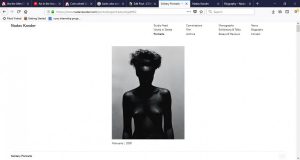For my new assignment, I have to talk about two great photographers. Yousuf Karsh, a photographer from the 20th Century and Nadav Kander, a photographer from the modern days.
Yousuf Karsh, Armenian Canadian photographer known for his famous portraits like Albert Einstein and others famous people. The work of Karsh is really interesting because even if he had everything in black and white you could see the photos perfectly. For example the portrait of Albert Einstein. In Einstein’s photo, the background is dark and even his shirt is dark, but just because he had a really strong light on his face, that’s what makes a photo powerful. Lighting can be tricky and it is possible that you might get a lot of bad photos, but when you get the right spot, everything will get its place. For Karsh’s work, I also will have to say that his photos are based on facial expression more than the body.
Besides Karsh’s photographs, Nadav Kander’s photographs give me a different feeling. Kander is a London Photographer who takes photographs of famous modern people. He has a lot of different photos with color and without color. Some of the photos have people with plenty of makeup and some with none. Also, his work is based on the face and the body. Something totally different to Karsh’s photographs. The facial expression is important in a photo and it’s even better when you can get the right pose for that photo. Also, Kander’s work shows not only bright colors but, different cool tones and blurry photos.
One portrait that I love is from Nadav Kander “Missy Elliot, 2006”. This is one of my favorite portraits because you can only see half of her face in the dark and those bright green and yellow colors.
For this new semester, my goal is to take better portrait photos because I know that I have the potential to do it.


 High Contrast, Dramatic Lighting
High Contrast, Dramatic Lighting


